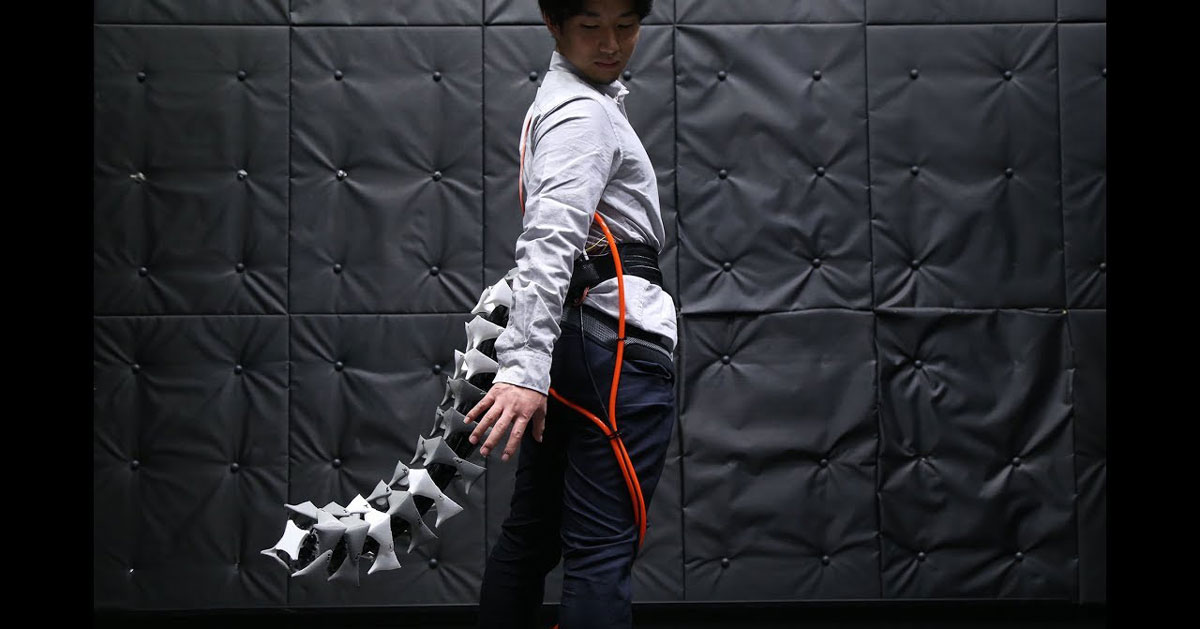'arque' is a robotic tail that improves human agility and balance
- Select a language for the TTS:
- UK English Female
- UK English Male
- US English Female
- US English Male
- Australian Female
- Australian Male
- Language selected: (auto detect) - EN

Play all audios:

RESEARCHERS AT KEIO UNIVERSITY IN JAPAN HAVE DEVELOPED A ROBOTIC TAIL THAT HUMANS CAN WEAR TO IMPROVE BALANCE. called ‘arque’, it was inspired by the way animals passively use their own
tails to improve mobility by shifting their center of gravity. images courtesy of keio university ARQUE CONSISTS OF INTERLOCKING PLASTIC VERTEBRAE THAT USE A SPRING-BASED STRUCTURE TO HANDLE
SHEARING AND TANGENTIAL FORCES. each vertebral joint is made up of one central plate, surrounded by an additional four protective plates, with the plates being linked together with elastic
cords. because of the modular, additional segments can be added, or removed, making the rail heavier or lighter depending on the wearers physique THE INTERNAL STRUCTURE OF THE TAIL USES FOUR
PNEUMATIC ARTIFICIAL MUSCLES THAT USE COMPRESSED AIR TO PROVIDE FORCE ON EIGHT DIRECTIONS DEPENDING ON THE ACTUATED MUSCLES. the tail is strapped around the user’s waist, and the user dons
a wearable body tracker that determines the user’s approximate center of gravity, which then prompts the tail to move and adjust itself accordingly as a corrective counterbalance. _‘FOR MOST
VERTEBRATE ANIMALS, TAIL PLAYS AN IMPORTANT ROLE FOR THEIR BODY, PROVIDING VARIANT FUNCTIONS TO EXPAND THEIR MOBILITY,’_ READS A STATEMENT OUTLINING THE PROJECT._ ‘in this work, arque, we
propose an artificial biomimicry-inspired anthropomorphic tail to allow us to alter our body momentum for assistive and haptic feedback applications.’_ RESEARCHERS STUDIED THE TAIL OF THE
SEAHORSE AS ITS STRUCTURE CAN HANDLE A HIGH AMOUNT OF FORCES, RELATIVE TO ITS SIZE. appendages in animals are typically round, but the seahorse tail has a square cross section with each
vertebra surrounded by four, interlocking L-shaped plates. THE TEAM IMAGINES A NUMBER OF POTENTIAL USES FOR THE DEVICE, INCLUDING COMBINING IT WITH SENSORS OR LINKING IT UP WITH BRAIN
SIGNALS TO CREATE AN ARTIFICIAL LIMB. it also imagines using use the tail as a gaming device to enhance user experience as wearers explore virtual worlds. PROJECT INFO RESEARCH BODY: keio
university NAME: arque TYPE: wearable technology kieron marchese I designboom aug 07, 2019